
Pinturicchio, or Pintoricchio, also known as Benetto di Biagio or Sordicchio, was an Italian painter during the Renaissance. He acquired his nickname because of his small stature and he used it to sign some of his artworks that were created during the fifteenth and sixteenth centuries.

Borgo is the 14th rione of Rome, Italy. It is identified by the initials R. XIV and is included within Municipio I.

The Minor Basilica of St. Lawrence in Damaso or simply San Lorenzo in Damaso is a parish and titular church in central Rome, Italy that is dedicated to St. Lawrence, deacon and martyr. It is incorporated into the Palazzo della Cancelleria, which enjoys the extraterritoriality of the Holy See.
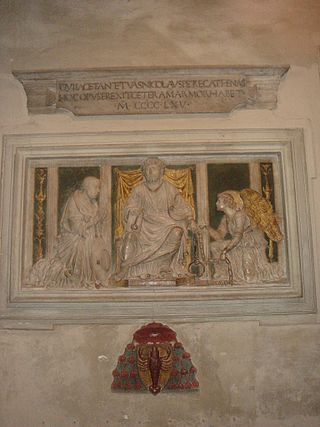
Andrea di Cristoforo Bregno (1418–1506) was an Italian Renaissance sculptor and architect of the Early Renaissance who worked in Rome from the 1460s and died just as the High Renaissance was getting under way.

The Via Giulia is a street of historical and architectural importance in Rome, Italy, which runs along the left (east) bank of the Tiber from Piazza San Vincenzo Pallotti, near Ponte Sisto, to Piazza dell'Oro. It is about 1 kilometre long and connects the Regola and Ponte Rioni.

The Palazzo della Consulta is a late Baroque palace in central Rome, Italy, that since 1955 houses the Constitutional Court of the Italian Republic. It sits across the Piazza del Quirinale from the official residence of the President of the Italian Republic, the Quirinal Palace.
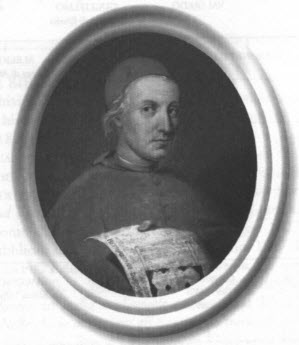
Domenico della Rovere was an Italian cardinal and patron of the arts.

The Demi-Gods Ceiling is a painted coffered ceiling by the Italian Renaissance master Pinturicchio, dating to c. 1490 and housed in the last of the suite of reception rooms in the Palazzo dei Penitenzieri in Rome, Italy. It comprises 63 octagonal coffers in gilded wood, decorated with allegoric and mythological figures on a faux-mosaic background, and painted on paper.
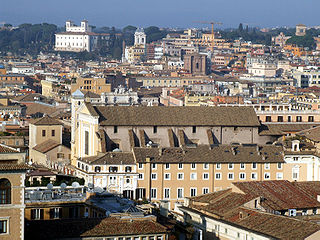
Santi Dodici Apostoli, commonly known simply as Santi Apostoli, is a 6th-century Roman Catholic parish and titular church and minor basilica in Rome, Italy, dedicated originally to St. James and St. Philip, whose remains are kept here, and later to all Apostles. Today, the basilica is under the care of the Conventual Franciscans, whose headquarters in Rome is in the adjacent building. It is the Station church for Friday, the first week of Lent.
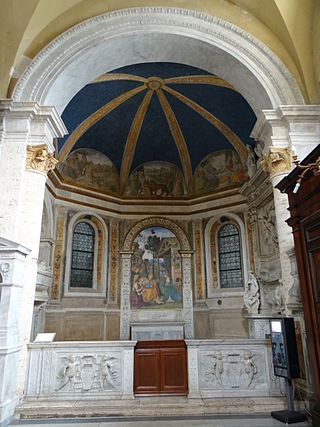
The Della Rovere or Saint Jerome Chapel, otherwise the Chapel of the Nativity is the first side chapel in the south aisle of the Basilica of Santa Maria del Popolo in Rome. It was dedicated to the Virgin and Saint Jerome and decorated with the paintings of Pinturicchio and his pupils. It is one of the best preserved monuments of quattrocento art in Rome.

Palazzo Cesi-Armellini, sometimes known plainly as Palazzo Cesi, is a late Renaissance building in Rome. It is considered important for historical and architectural reasons. The palace, which should not be confused with Palazzo Cesi-Gaddi, Palazzo Muti-Cesi, or the destroyed Palazzo Cesi, placed also in Borgo near the southern Colonnade of St. Peter's square, is one of the few Renaissance buildings of the rione Borgo to have survived the destruction of the central part of the neighborhood due to the 20th century construction of Via della Conciliazione, the avenue leading to St. Peter's Basilica. Today, it is owned by the Society of the Divine Savior and part of it is used as their motherhouse.

Palazzo Serristori is a Renaissance building in Rome, important for historical and architectural reasons. The palace is one of the few Renaissance buildings of the rione Borgo to have outlived the destruction of the central part of the neighborhood due to the building of Via della Conciliazione, the grand avenue leading to St. Peter's Basilica.

Palazzo dei Convertendi is a reconstructed Renaissance palace in Rome. It originally faced the Piazza Scossacavalli, but was demolished and rebuilt along the north side of Via della Conciliazione, the wide avenue constructed between 1936 and 1950, which links St Peter's Basilica and the Vatican City to the centre of Rome. The palace is famous as the last home of the painter Raphael, who died there in 1520.

Palazzo Alicorni is a reconstructed Renaissance building in Rome, important for historical and architectural reasons. The palace, originally lying only a few meters away from Bernini's Colonnades in St. Peter's square, was demolished in 1931 in the wake of the process of the border definition of the newly established Vatican City state, and rebuilt some hundred meters to the east. According to the stylistic analysis, his designer had been identified as Giovanni Mangone, a Lombard architect active in Rome during the 16th century.
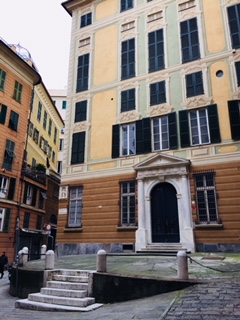
The Palazzo Clemente della Rovere is a palace located in Piazza Rovere in the historical center of Genoa, Northwestern Italy. The palace was one of the 163 Palazzi dei Rolli of Genoa, the selected private residences where the notable guests of the Republic of Genoa were hosted during State visits. On 13 luglio 2006 it was added to the list of 42 palaces which now form the UNESCO World Heritage Site Genoa: Le Strade Nuove and the system of the Palazzi dei Rolli. The palace hosts today the General Consulate of Iceland.

Borgo Nuovo, originally known as via Alessandrina, also named via Recta or via Pontificum, was a road in the city of Rome, Italy, important for historical and architectural reasons. Built by Pope Alexander VI Borgia for the holy year of 1500, the road became one of the main centers of the high Renaissance in Rome. Borgo Nuovo was demolished together with the surrounding quarter in 1936–37 due to the construction of Via della Conciliazione.

Borgo Vecchio, also named in the Middle Ages Via Sancta, Carriera Sancta or Carriera Martyrum, was a road in the city of Rome, Italy, important for historical and architectural reasons. The road was destroyed together with the adjacent quartier in 1936–37 due to the construction of Via della Conciliazione.

Piazza Scossacavalli, also named Piazza di San Clemente, Piazza di Trento, Piazza d'Aragona, Piazza Salviati, was a square in Rome, Italy, important for historical and architectonic reasons. The square was demolished together with the surrounding quarter in 1937 due to the construction of Via della Conciliazione.

Borgo Santo Spirito is a street in Rome, Italy, important for historical and artistic reasons. From a historical point of view, it is considered the most interesting street in the Borgo district. Of medieval origin, it is linked to the foundation of the ancient fortified hospice for pilgrims from England, the Burgus Saxonum. The street houses the oldest Roman hospital, the Arcispedale di Santo Spirito in Saxia, which gave it its name. Heavily altered during the works for the opening of Via della Conciliazione, it nevertheless avoided the fate of the two parallel streets of Borgo Nuovo and Borgo Vecchio, both destroyed.

The Theatre of Nero was the private theatre erected in Rome by Nero, the Roman emperor between AD 54 and AD 68. It was known only from literary sources until its remains were discovered in 2020 during excavations. The remains were excavated through 2023 by the Special Archaelogical Superintendency of Rome. It was announced that same year the remains were discovered.






















